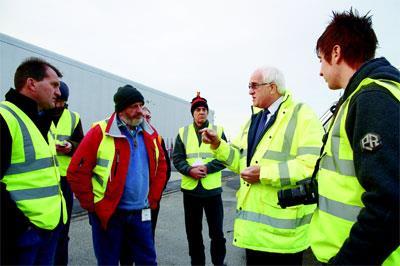
Chaired by the ubiquitous Quentin Willson, who spoke with passion and humour on behalf of FairFuelUK, Microlise’s transport conference earlier this month saw eight keynote speakers agreeing on two things.
Firstly, that driver training is not just nice to have, it is essential; and secondly, the scope of telematics provision is almost too great.
And the selection of industry heavyweights behind the lectern revealed that they all had different priorities and the benefits of a good telematics product lie in getting it tailored to operators’ specific needs.
Figures quoted on fuel consumption improvements were consistently in the 10% to 13% range and the traffic-light style of driver coaching devices are well known, but how the information is used varies.
Representing the traditional haulier, Grangemouth-based John Mitchell warned against too swift a decision on the choice of a telematics provider. "We started with telematics eight years ago and we spent the first two years with a poor system that wasted a lot of money."
Benefits
More than happy with his new package, Mitchell put improved information flow to his customers as one of the biggest benefits, ranking it a close second to fuel gains.
Boosted safety levels were cited by several, none more so than Mark Binns, Hoyer director of petroleum logistics. "We use safety management as our business model and a good telematics package is at the core of it. We focus on safety 100% and we find that good fuel returns follow naturally from that," he said.
He agreed that driver buy-in to training and performance management was essential, but he warned that the training skills are not easy to come by. "The interpersonal skills required from driver trainers are very specific. Lots of people think they can do it, and they can’t," he said.
Hoyer publishes the rankings of all drivers at their depots and they are happy to leverage peer pressure to get results. Binns added: "Training can also be targeted at an individual driver’s weaker areas. It’s pointless training him to do things he’s already good at."
Double-edged sword
Apart from the dispassionate measurement of driver performance, an increasing number of hauliers are installing in-cab cameras. Common on buses, they are a double-edged sword when it comes to establishing blame after an incident, but they help get to the truth and save money in the process.
Richard Auty, a member of the forensic collision investigation unit at the Metropolitan Police, outlined the difficulties of establishing the guilty party in a collision: "Eyewitnesses are notoriously unreliable and it’s little better with only tachograph or track-and-trace evidence as they are incomplete and of limited use."
He said when a vehicle is involved in an accident and a prosecution is possible, it could have detrimental effects on an operator. "Vehicles are commonly impounded for more than a year while the laborious information gathering and court processes takes place. With good data, either from onboard CCTV or an incident data recorder linked to a vehicle CAN-BUS, this can be cut to weeks or even days. They are a good investment."
Delivering better customer service was at the heart of a good telematics package for some. Simon Wilson, chartered safety practitioner for DHL supply chain was certain that it wins and retains business. "Customers are looking for world-class KPIs and we have to provide them," he said.
With a fleet that covers 800 million km a year in the UK, and depots that can have an agency driver headcount of as much as 50%, he was candid about the issues. "We know our drivers speed, but contextual mapping that allocates speeds to location has helped."
He agreed that there was so much information available, that the real value comes only from a tailored system that addresses operators’ specific operating conditions.
Where’s my shopping?
The last word went to Cliff Cheeseman, fleet training manager for Tesco.com. With nearly 10,000 customer delivery assistants – van drivers to you and I – with non-vocational licences, and a staff turnover that peaked at 40%, his need for driver training and telematics back-up, was urgent. It was implemented four years ago and had an instant effect, he said.
Accidents, insurance claims and fuel bills were slashed and he can now answer the "Where’s my shopping?" question from customers, with a text message. Every little helps, it would seem.














